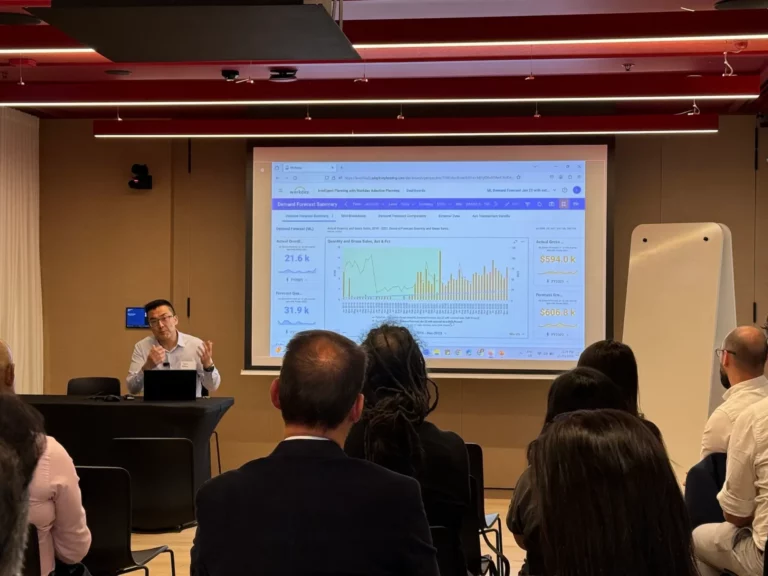
2025 Financial Planning Trends Every CFO Should Know
What are the defining trends for finance leaders in 2025? Learn about the importance of upskilling finance teams, adopting cloud-based solutions, and AI as a key enabler of integrated finance.
Enterprise Performance Management (EPM), also referred to as Corporate Performance Management involves measuring, analysing and reporting the performance of an organisation. It includes processes of planning, budgeting, forecasting and reporting.
Organisations who practise strong Enterprise Performance Management reap the rewards of truly understanding their business, being able to pivot based on real-time insights, and remaining competitive to drive business success and longevity.
Enterprise Performance Management is not just reporting or what your business intelligence tool can give you. It is much more. The benefits of EPM include:

What are the defining trends for finance leaders in 2025? Learn about the importance of upskilling finance teams, adopting cloud-based solutions, and AI as a key enabler of integrated finance.


We discuss what financial management and strategic planning looks like for health and aged care organisations, alongside CFOs of Infinite Care and ECH, Zane Ali and Merrin Nancarrow.


In this whitepaper, we explore the challenges faced by finance teams in professional services. We discuss their role in strategic planning, mitigating risks, and enhancing overall efficiency.


Here’s how Workday Adaptive Planning enabled Douglas Partners’
finance team turn from number crunchers to business partners


Get the latest updates and highlights of each new released feature of Workday Adaptive Planning to enhance your instance.


Do you need Workday Adaptive Planning if you already use Power BI? While both tools are powerful, they serve different purposes in an organisational setting.
Planning, budgeting and forecasting is an important part of any business. When done poorly, they lose meaning as they becomes outdated and the organisation relies on outdated or incomplete data.
But when done well, it enables finance and the entire business to truly measure, track and deliver performance.
The benefits of strong planning, budgeting and forecasting include:


In this whitepaper, we explore the challenges faced by finance teams in professional services. We discuss their role in strategic planning, mitigating risks, and enhancing overall efficiency.


Learn how Save the Children transformed financials and maximised their mission impact with Workday Adaptive Planning.


Are you using Microsoft Dynamics 365 ERP or another cloud-based ERP? Learn how you can get more from your Financial Planning and Analysis capability in this video.
QMetrix has worked with organisations across many industries to achieve their Enterprise Performance Management, and Financial Planning and Analysis goals.
Learn about the challenges, solutions and outcomes in these case studies of real businesses like yours.
“Workday Adaptive Planning has fundamentally changes the way we work. It provides a wealth of accurate information quickly. With it we can forecast, see pipeline, and manage our existing portfolio of loans.
The dashboards provide a brilliant overview of everything we need to know.” – Justin Smart, Chief Operation Officer, Trilogy Funds


Here’s how Workday Adaptive Planning enabled Douglas Partners’
finance team turn from number crunchers to business partners


Learn how Save the Children transformed financials and maximised their mission impact with Workday Adaptive Planning.


Learn how Beyond Blue achieved a simplified and streamlined budgeting, forecasting and reporting process, and quicker decision making across the organisation with Workday Adaptive Planning.


Learn how Australian residential aged care provider Infinite Care implemented Workday Adaptive Planning to enhance their budgeting, forecasting and planning.


TGI Sport chose Workday Adaptive Planning, transitioning from manual processes to a streamlined, automated approach for improved financial planning.


Learn how Designworks changed their Financial Planning and Analysis process to one that is smoother, cleaner, easier, more accurate and more insightful.
From the CEO to the operations and marketing teams, everyone relies on key reports to understand how the business is performing and to make decisions on many levels.
Reports with poor data quality from disparate systems result in organisations that are bogged down by too much manual consolidation, poor business intelligence, and decisions based on outdated data.
That’s why implementing best practices in reporting are important. You want to have reports that provide timely, accurate insights in context that will help your business stay agile and able to respond to marketplace changes.
What are the benefits of good reporting?


Learn how Bevilles could model and plan scenarios quickly, and manage their retail business on a store level while giving management a better overview.


Learn how Tennis Australia achieved an integrated budgeting, forecasting and reporting solution and wider business goals with Workday Adaptive Planning.


To complement Microsoft Business Central, not-for-profit cohealth brought in Workday Adaptive Planning. Learn how it changed budgeting, forecasting and reporting at cohealth.
Workday Adaptive Planning is a leading cloud-based Enterprise Performance Management system that enables organisations to conduct continuous planning, reporting and analysis.
It is rated as a top performer on sites like Gartner, TrustRadius and G2 Crowd based on its features and high customer satisfaction rating.
What are the benefits of Workday Adaptive Planning? With this Enterprise performance management system, your finance team can spend less time on manual data entry, consolidation and checking across spreadsheets.
Instead, they can focus on more analysis and value-adding work – because the system simplifies their work.
The wider organisation also benefits, with access to more reliable and timely data that provide a timely representation of the organisation, and drives agile decision-making to deliver results.


QMetrix has been named Workday Adaptive Planning Partner of the Year in the region for the second time.


Do you need Workday Adaptive Planning if you already use Power BI? While both tools are powerful, they serve different purposes in an organisational setting.


Learn how Save the Children transformed financials and maximised their mission impact with Workday Adaptive Planning.
Workday Adaptive Planning is highly rated by finance teams for its practical features which enable planning, budgeting, forecasting and reporting in a way that just makes better sense for finance teams. It lessens manual work and clunky spreadsheets, and empowers your team to focus on analysis and strategy instead.
Workday Adaptive Planning also empowers the wider organisation to understand and manage performance as a whole, and drive data based decisions that lead to more successful business outcomes.
What can Workday Adaptive Planning do? Its features include:


Get the latest updates and highlights of each new released feature of Workday Adaptive Planning to enhance your instance.


Learn key elements of building reports in OfficeConnect including workbook properties, applying elements, copy and paste, and find and replace.


The latest 2022R2 release has delivered many improvements. Here, we showcase the more complex enhancements, namely Alternate Calendars and Contra Accounts.
It has been a struggle for organisations to retain talent in a constantly changing marketplace. But people are core to every business, and we need the right people in the right place at the right time.
With proper workforce planning that integrates HR, finance and operations, your organisation can achieve its strategic goals and deliver results.
What are best practices in workforce planning? How can we plan in a way that sets us up for success now and in the future?
What are the benefits of Workforce Planning?


What challenges are finance teams in Allied Health and related organisations facing, and how these can be effectively tackled? Read the whitepaper here.


Learn how Bevilles could model and plan scenarios quickly, and manage their retail business on a store level while giving management a better overview.


A key challenge for finance leaders is managing cashflow to support operations and capital position to support strategic growth. Learn about the disciplines, processes and technology that can help you do this.
A solution is never bought alone – it must often be considered in relation to others in the organisation’s digital ecosystem. When software is integrated, interoperability is enhanced, allowing systems and applications to work together.
A key strength of Workday Adaptive Planning is it can seamlessly integrate with multiple data sources including ERP, CRM, GL and other data warehouses. These include Microsoft Dynamics, NetSuite, Pronto, Xero and more.
What are the benefits of software integration? When data flows automatically between your systems, you can:


Solve your Dynamics planning and reporting issues today. More than 400 customers integrated Adaptive Insights with Dynamics.
QMetrix organises webinars and events, and participates in other events, to share how organisations can benefit from corporate performance management solutions.
What you can expect from QMetrix webinars and events (varies based on event):


On 21st March 2024, QMetrix’s Workday Adaptive Planning team hosted an exclusive event for our Premium Care clients.


Join us for this webinar as we discuss how rolling forecasts can empower your finance team to navigate the business landscape and drive business growth, and share best practices on how to get it done well.


Finance leaders, join these free webinars hosted by FP&A experts who will share their experiences and best practices. These events are hosted by Adaptive Insights.
We’ve worked with businesses across Australia to do just that. Let’s chat about how it could work for your organisation too.
This website uses cookies to ensure you get the best experience on our website. More Information